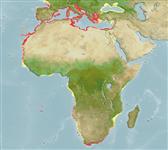>
Eupercaria/misc (Various families in series Eupercaria) >
Sparidae (Porgies)
Etymology: Diplodus: Greek, diploos = twice + Greek, odous = teeth (Ref. 45335).
More on author: Linnaeus.
Issue
This subspecies is reported to have no genetic difference between the subspecies Diplodus sargus cadenati. See V.S. Domingues et al. 2007. Journal of Experimental Marine Biology and Ecology 346 (2007):102-113 (F. M. Porteiro, pers.comm. 02/08). Presence in Canary Is. to be reviewed since D. bellottii and D. cadenati are recognized as valid species, not any more as subspecies of D. sargus.
Environment: milieu / climate zone / depth range / distribution range
البيئة
بحري; مياه مخلوطة القاع; محيطية (Ref. 51243); نطاق العمق 0 - 50 m (Ref. 12460), usually 0 - 50 m (Ref. 13780). Subtropical; 48°N - 36°S, 29°W - 42°E
Northeastern Atlantic from Brittany (France) to Gibraltar, and Madeira I.; Mediterranean Sea and southwestern Black Sea.
Length at first maturity / الحجم / وزن / العمر
Maturity: Lm ?, range 25 - ? cm
Max length : 45.0 cm TL ذكر/ مختلط الجنس; (Ref. 3397); common length : 22.0 cm TL ذكر/ مختلط الجنس; (Ref. 3397); أعلا وزن تم نشرة: 1.9 kg (Ref. 40637); العمر: 10 سنين (Ref. 26328)
الأشواك الظهرية (المجموع) : 11 - 12; الأشعة الظهرية الناعمة (المجموع) : 12 - 15; شوكة شرجية: 3; أشعه شرجية لينه: 11 - 14. Body with 5 black and 4 grey vertical bands. Snout is longer than the eye diameter (Ref. 35388).
Inhabits coastal rocky reef areas (Ref. 12460) and Posidonia oceanica beds. Like other sparids, it is very active and frequents the surf zone, primarily at dawn (Ref. 13780). Feeds on shellfish and other benthic invertebrates which it picks from the sediment (Ref. 5377).
Sexes separate or protandrous (Ref. 4781). In some areas, this species occurs as a digynic hermaphrodite, that is, males and females developing from intermediate juveniles (Ref. 52202). However, protandry with possible digyny was later confirmed (Ref. 103751). Reaches sexual maturity at 2 years, with an approximate size of 17 cm. Spawning happens from January to March. Egg size 0.8-0.9 mm; larval length at hatching 2.6 mm. Also Ref. 28504.
Bauchot, M.-L., 1987. Poissons osseux. p. 891-1421. In W. Fischer, M.L. Bauchot and M. Schneider (eds.) Fiches FAO d'identification pour les besoins de la pêche. (rev. 1). Méditerranée et mer Noire. Zone de pêche 37. Vol. II. Commission des Communautés Européennes and FAO, Rome. (Ref. 3397)
IUCN Red List Status (Ref. 130435)
استخدامات بشرية
مصائد: غير مهمة تجارياً; الأستزراع المائي: تجاري; لعبة سمكه: نعم
أدوات
تقارير خاصة
Download XML
مصادر علي الأنترنت
Estimates based on models
Preferred temperature (Ref.
123201): 15 - 24.1, mean 18.8 °C (based on 400 cells).
Phylogenetic diversity index (Ref.
82804): PD
50 = 0.5000 [Uniqueness, from 0.5 = low to 2.0 = high].
Bayesian length-weight: a=0.01175 (0.01050 - 0.01315), b=3.04 (3.01 - 3.07), in cm total length, based on LWR estimates for this species (Ref.
93245).
مستوى غذائي (Ref.
69278): 3.4 ±0.1 se; based on diet studies.
المرونه (Ref.
120179): وسيط, الحد الزمني الأدني لتضاعف عدد أفراد المجتمع 1.4-4.4 سنة (K=0.11-0.25; tmax=10; tm=2).
Prior r = 0.54, 95% CL = 0.35 - 0.80, Based on 5 data-limited stock assessments.
Fishing Vulnerability (Ref.
59153): High vulnerability (57 of 100).
Climate Vulnerability (Ref.
125649): Low to moderate vulnerability (26 of 100).
Nutrients (Ref.
124155): Calcium = 74.5 [38.6, 152.0] mg/100g; Iron = 0.993 [0.559, 1.844] mg/100g; Protein = 19.7 [18.8, 20.6] %; Omega3 = 0.35 [0.20, 0.60] g/100g; Selenium = 20.9 [9.8, 39.7] μg/100g; VitaminA = 15 [5, 42] μg/100g; Zinc = 1.01 [0.69, 1.43] mg/100g (wet weight); based on
nutrient studies.
